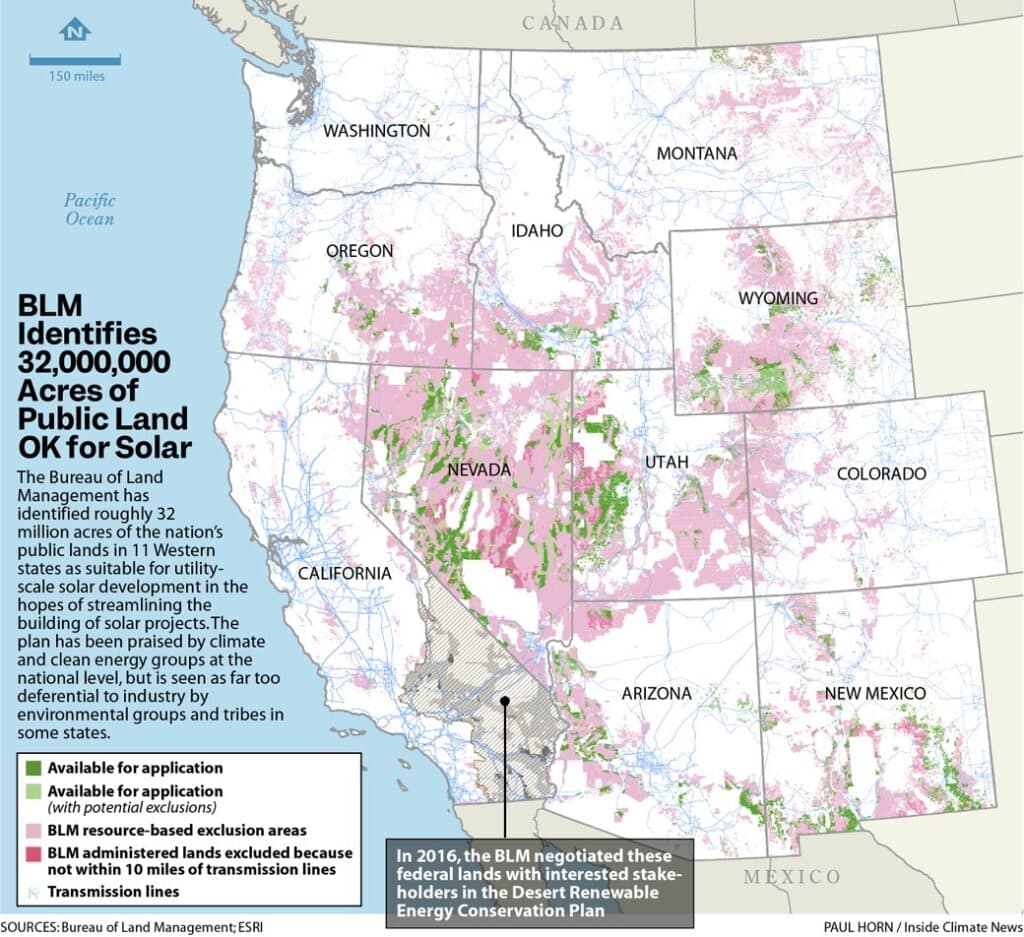It’s past time for a follow-up to Sharon’s post on the BLM’s western solar plan. The final plan was released at the end of August. The BLM says it received 162 formal protests during that 30-day protest period that are being reviewed (but apparently won’t release the names of the parties, unlike the Forest Service objection process).
A number of conservation groups have protested the failure to protect the integrity of the Old Spanish National Historic Trail. Lynn County, Nevada, just southeast of Reno, is concerned the proposed plan will “result in fiscal impacts as it will be left to deal with speculative solar applications in inappropriate areas.” Apparently, the Western Congressional Caucus doesn’t like it because it “risks taking lands offline for purposes other than solar use, limiting the potential for mining, grazing and public access.” And, of course, enviros are unhappy, too.
According to the BLM,
“It would make over 31 million acres of public lands across 11 western states available for potential solar development, driving development closer to transmission lines or on previously disturbed lands and avoiding protected lands, sensitive cultural resources and important wildlife habitat.
Steering project proposals away from areas where they may conflict with other resources or uses will help ensure responsible development, speed the permitting process, and provide greater predictability to the solar energy industry.”
That sounds like good planning. However, a scientist says that, instead, “It makes available to solar areas that are ecologically sensitive, areas that include sensitive species. It stands to significantly impact and alter ecosystems across the Great Basin and Mojave Desert.” The federally threatened desert tortoise is a particular concern.
The Center for Biological Diversity would have opted for an alternative that prioritized already developed or degraded areas on public lands and rooftop solar on structures. There seems to be some debate about whether it is necessary to essentially plow up the desert in order to install solar facilities. But things may be different in Wyoming, where local conservationists see this as additional protection for big game habitat.
And then there’s some “sensitive cultural resources” that got missed.
There are also questions about how responsive the BLM will be to site-specific concerns that arise when more information is available for a proposed project. We have an early example of that with the Rough Hat Clark Solar Project in Nevada. According to E & E news, “The Bureau of Land Management is paving the way for a major solar power project to be built in a valley west of Las Vegas despite the objections of environmental groups that have petitioned the agency to protect the region.”
This is obviously a very large-scale planning effort, where it is not possible to identify more localized issues (though it seems like there was local knowledge that was provided by the public that might have been incorporated). The total acreage “available” is admittedly much greater than what is needed, so presumably further “unavailability” is expected and will be provided as future projects are considered. As a Wyoming representative of the Wilderness Society put it, “The implementation is going to matter.” A final decision is expected by the end of the year.

Very nice summary. Rough Hat solar and most projects in the planning process will be grandfathered into the old western solar plan. Similar to what happened in the initial western solar plan, projects proposed were grandfathered in; some developers were still rolling out grandfathered projects up until to a few years ago.
There is a good case that the reasonable foreseeable development scenario underlying the estimate of acreage needed is flawed and underestimates the amount of acreage that will be developed. The underlying DOE analysis was not up to date re: tax credits for solar, it had it stepping down and zeroing out.. and IRA extended it through 2032. BLM could have used the later analyses that updated this info, but apparently did not. The model they use is very sensitive to tax credits in deployment, without it, more gas gets deployed. There are also some pretty arbitrary splits between public and private lands in the estimate. So hard to say exactly how many acres will be developed. BLM also did not include the 80% reduction in capacity rents for solar on public lands. Based on projects I’m tracking they will hit 700k by 2030 or so, alot sooner that WSP suggests.
The key issue I see is that BLM turned a least-conflict siting approach into a transmission-corridor first siting approach. The least-conflict path has worked well in California, zero litigation since DRECP passed; worked so well that the state was able to get BLM to walk back its attempted revision early in this western solar plan update. The existing plan also seems to be working well for developers, considering the amount of projects proposed/permitted/in planning.
Its also unclear that what is being proposed as conserved lands in the additional five states via the western solar plan, are even available for solar leasing without some other authorization. So calling lands set aside via this process, maybe that works..
The cultural resource conflict is really unfortunate. Internal agency conversations seem like they should have caught that.